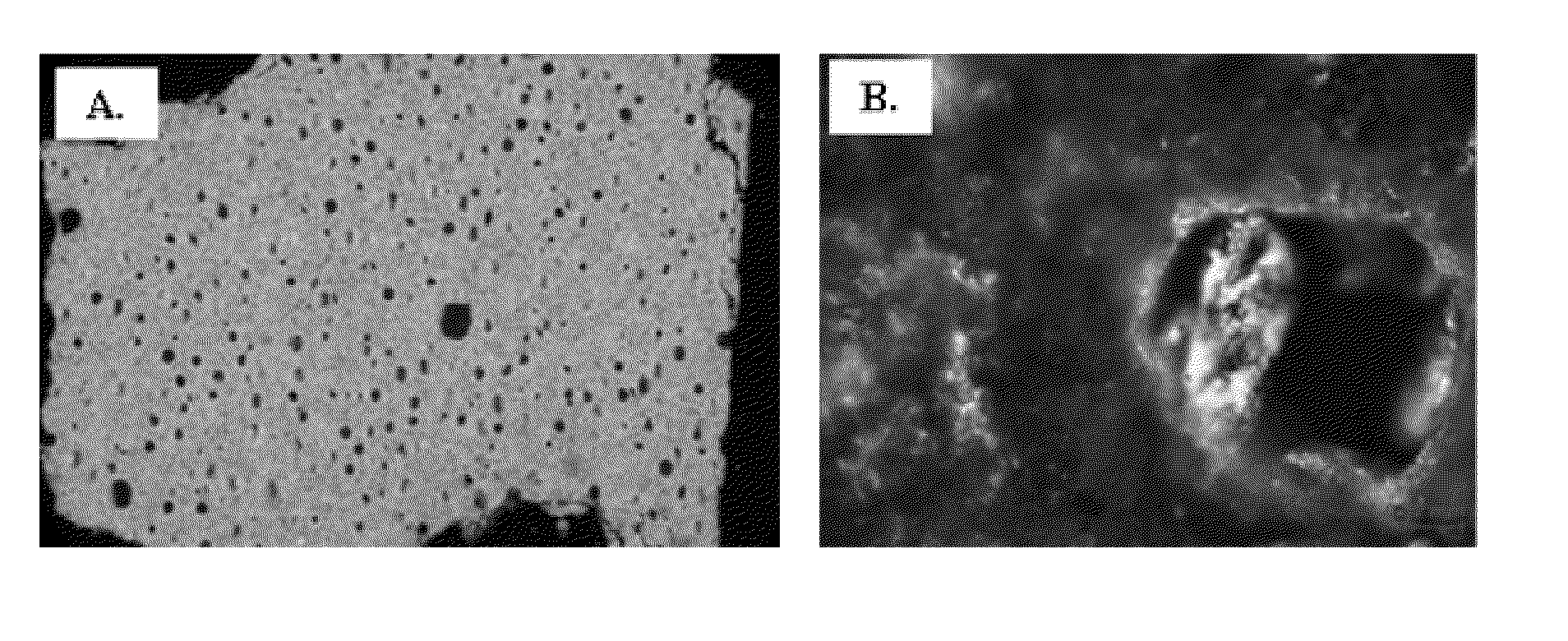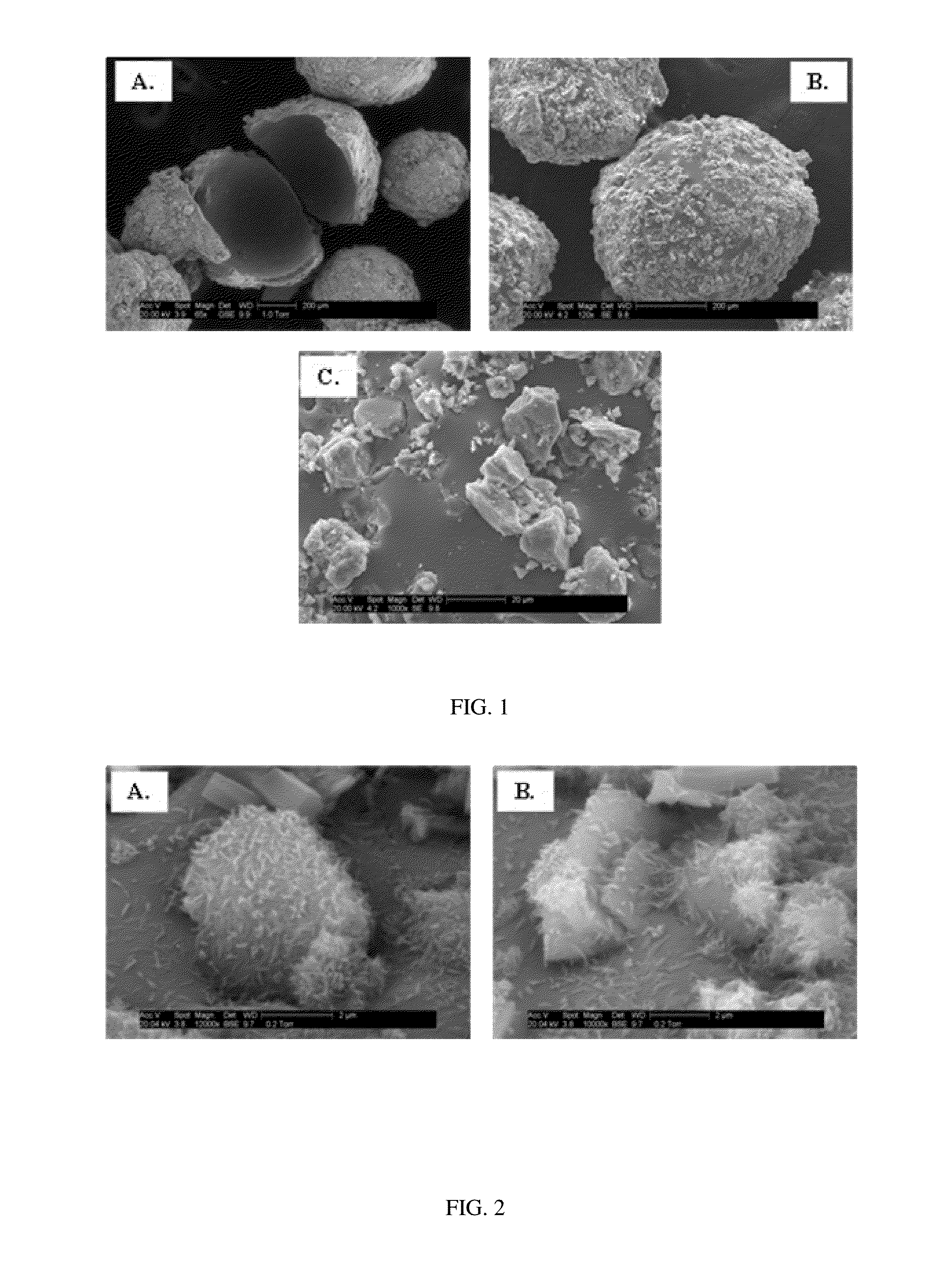Lightweight hollow particles for use in cementing
a technology of light weight hollow particles and cementing, which is applied in the direction of cementware, sealing/packing, and well accessories, etc., can solve the problems of reducing the quality of cement, and not meeting all the requirements stated abov
- Summary
- Abstract
- Description
- Claims
- Application Information
AI Technical Summary
Benefits of technology
Problems solved by technology
Method used
Image
Examples
example 1
[0056]A 1.5% carboxymethyl cellulose (CMC) in water solution was prepared by dissolving 1.5 grams of CMC as binder in 98.5 grams of deionized water. A lightweight precursor composition was prepared by mixing 83 g borosilicate glass and 5 g bentonite and then adding 12 g calcium carbonate in a jar mill for about one hour. Prior to mixing the bentonite, glass and calcium carbonate were sieved to be less than 325 mesh. About 200.0 grams of the lightweight particle powder was placed in the pan of the lab scale version of an Eirich mixer. Using an atomizer, 57.0 grams of the 1.5% CMC solution was sprayed onto the powder while the pan was rotated at 74 rpm and the contra rotating impeller at 1250 rpm. The binder solution and powder were allowed to mix at this mixer setting for 2 minutes to form spheres. To prevent the spheres from agglomerating, 40.0 grams of bentonite was added to the pan as a parting agent and this was rotated, without the impeller, for 1 minute. The spheres were then r...
example 2
[0058]This Example describes the preparation of hollow spheres having an active surface. A 1.5% CMC in water solution was prepared by dissolving 1.5 grams of CMC in 98.5 grams of deionized water. About 200.0 grams of lightweight particle precursor powder (<325 mesh) was placed in the pan of the lab scale version of an Eirich mixer. Using an atomizer, 57.0 grams of the 1.5% CMC solution was sprayed onto the powder while the pan was rotated at 74 rpm and the contra rotating impeller at 1250 rpm. The binder solution and powder were allowed to mix at this mixer setting for 2 minutes to form spheres. 600 g of cement powder was added to the pan as the parting agent and this was rotated, without the impeller, for 1 minute. Once dried in a vacuum oven at 100° C. for 4 hours, the spheres were heat treated at a rate of 10° C. / min to 800° C. for 20 minutes in a muffle furnace.
[0059]During the heat treatment, while the glassy spheres were semi-molten, cement grains were embedded in the outer su...
example 3
[0061]Following the procedure of Example 1, hollow microspheres were prepared using varying percentages of bentonite clay and glass. Strength of the hollow microspheres was obtained using an Instron 3345 Load Frame to determine the maximum loading the particles could withstand before fracture (each loading being an average of the max loading of 20 particles) and densities were obtained using a Micromeretics AccuPyc 1330 Gas Pycnometer. The results are set forth in Table 1 below:
Table 1
[0062]
TABLE 1Composition versus strength and density of hollow spheres.%%%SDMax LoadGlassBentoniteCaCO3(g / cc)(lbs)835120.771.47810121.673.85632121.856.85038122.1019.6
Table 1 demonstrates that higher percentages of bentonite cause the glassy composition to resist expansion and produce less expanded lightweight particles with higher strength and higher density.
PUM
| Property | Measurement | Unit |
|---|---|---|
| hydrostatic pressures | aaaaa | aaaaa |
| densities | aaaaa | aaaaa |
| particle size | aaaaa | aaaaa |
Abstract
Description
Claims
Application Information
 Login to View More
Login to View More - R&D
- Intellectual Property
- Life Sciences
- Materials
- Tech Scout
- Unparalleled Data Quality
- Higher Quality Content
- 60% Fewer Hallucinations
Browse by: Latest US Patents, China's latest patents, Technical Efficacy Thesaurus, Application Domain, Technology Topic, Popular Technical Reports.
© 2025 PatSnap. All rights reserved.Legal|Privacy policy|Modern Slavery Act Transparency Statement|Sitemap|About US| Contact US: help@patsnap.com



